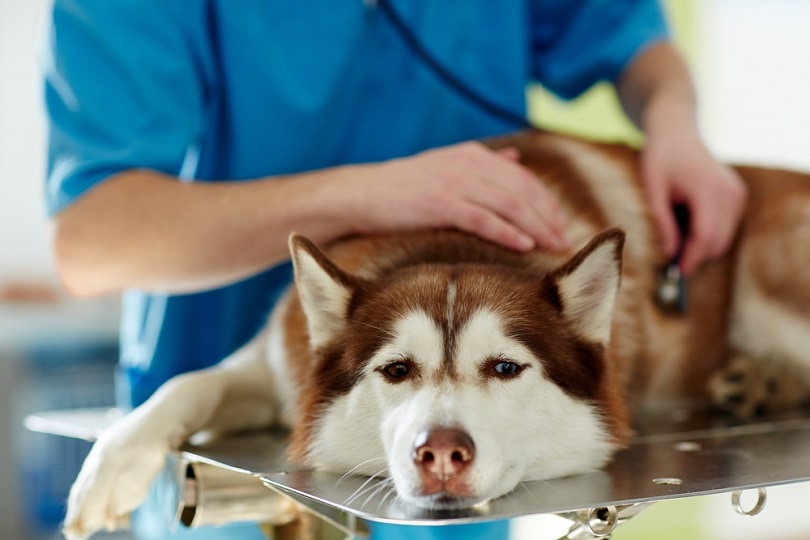
Click to Skip Ahead
Let’s face it, chocolate is hard to resist. Whether you enjoy the taste of silky smooth milk chocolate or the slightly bitter taste of the dark variety, chocolate holds universal appeal. It’s no wonder that our canine companions are tempted to steal a piece of chocolate when the opportunity presents itself.
Chocolate toxicity is common in dogs as slabs of chocolate and chocolate-containing food items are frequently kept in the home. According to the American Society for the Prevention of Cruelty to Animals (ASPCA), chocolate comes in at number four of the top 10 most commonly reported pet toxins.1 Chocolate is toxic to dogs because it contains a compound called theobromine and when ingested by pups, can be lethal. Let’s take a closer look at why one of humans’ favorite treats is a huge no-no for our canine friends.
What Makes Chocolate Toxic to Dogs?
Chocolate is toxic to dogs mainly due to its theobromine content, and to a lesser extent, its caffeine content. These naturally-occurring compounds are found in the cocoa bean and belong to a group of chemicals known as methylxanthines.
So why is it that we can safely eat chocolate, but our canine companions can’t? Unlike people, dogs are not effective at processing theobromine or caffeine, making them more sensitive to the chemicals’ effects.
After being absorbed by the gastrointestinal tract, theobromine and caffeine are distributed throughout the body and affect the heart, respiratory, and nervous system.
It is important to be aware that chocolate and other chocolate-containing food items may also contain other substances that are toxic to dogs, such as raisins, xylitol, and nuts.

How Much Chocolate Is Toxic to Dogs?
As the old adage goes, the dose makes the poison—this is particularly apt for chocolate. Chocolate toxicity is dependent on the type of chocolate, how much is eaten, as well as the size of the dog. Small dogs are more at risk of chocolate toxicity.
According to the Veterinary Information Network (VIN), the average toxic dose of theobromine for dogs is 45.3 mg per pound of body weight, while the toxic dose of caffeine is approximately 63.5 mg per pound. However, dogs have varying sensitivities to these compounds. In general, mild signs, such as vomiting and diarrhea, may be seen in dogs ingesting 9 mg of chocolate per pound, effects of the heart may be seen at 18–23 mg per pound, and seizures may occur at dosages ≥27 mg per pound.
The exact amount of methylxanthines in chocolate varies due to the variation of cocoa beans as well as the formulation of the chocolate. As a rule, the darker and more bitter the chocolate, the more dangerous it is to dogs. Dry cocoa powder contains the highest concentration of methylxanthines (~800 mg per ounce), followed by baker’s chocolate (~450 mg per ounce), semisweet chocolate and sweet dark chocolate (~150–160 mg per ounce), and milk chocolate (~64 mg per ounce). White chocolate has a negligible concentration of this toxic compound.
Merck Veterinary Manual has a chocolate toxicity calculator that can be used to calculate the total amount of methylxanthines ingested and indicates whether or not your dog needs veterinary treatment based on the size of your dog, the type of chocolate ingested, and the amount of chocolate ingested. You can find the calculator here.
For example, a medium-sized dog weighing 40 pounds only needs to eat roughly 1 ounce of baker’s chocolate, or 9 ounces of milk chocolate, to potentially show signs of poisoning, while a small-sized dog weighing 10 pounds would potentially show signs of poisoning after eating approximately a quarter of an ounce of baker’s chocolate, or 2 ounces of milk chocolate.
What Are the Signs of Chocolate Toxicity?
The clinical signs are dependent on the dose of methylxanthines ingested. For many dogs, the most common early signs of chocolate toxicity are diarrhea, vomiting, restlessness, a rapid heartbeat, and panting. These initial signs can lead to muscle tremors, seizures, and an irregular heartbeat. If large enough quantities of chocolate are ingested, it can be life-threatening. Even if the quantity of chocolate ingested is not toxic, dogs can still become ill and develop pancreatitis from chocolate’s high fat content.
Signs of chocolate toxicity occur approximately 1–4 hours after ingestion, but can sometimes be seen after 6–12 hours. If a large amount of chocolate is eaten, the signs can last for days as theobromine stays in the bloodstream for a long period of time. Theobromine can also be reabsorbed from the bladder.

What Should I Do If My Dog Eats Chocolate?
Stay calm and try to figure out how much chocolate your dog has eaten as well as the type of chocolate eaten. Call your local veterinarian or pet poison hotline or use the Merck Veterinary Manual chocolate toxicity calculator mentioned above to see if your dog has ingested a toxic amount of chocolate. If a toxic amount of chocolate was eaten, your dog should be seen by a veterinarian as soon as possible. If it’s not possible to work out how much chocolate your dog has eaten, your dog should also be taken to a veterinarian as soon as possible. The sooner your dog receives treatment, the better the prognosis.
How Is Chocolate Toxicity Diagnosed?
Unfortunately, the signs of chocolate toxicity are nonspecific and the signs are similar to a number of other conditions, such as some other drug toxicities, neurological disease, or metabolic disease. A diagnosis is made based on a known history of chocolate ingestion or ingestion of chocolate-containing food items. Chocolate may also be seen in vomit after a dog is made to throw up at the vet clinic.

What Is the Treatment for Chocolate Toxicity?
There is no specific antidote for theobromine and caffeine. If discovered early enough, your veterinarian will induce vomiting in an attempt to empty the stomach of any chocolate that may have been eaten and to stop further absorption of the toxic compound (do not attempt to induce vomiting yourself). The dog will be treated with several doses of activated charcoal to prevent the absorption of theobromine and caffeine into the body. This may be the only treatment that is necessary if treatment is started early and the dog has not started showing signs of chocolate toxicity.
Dogs that are already showing signs of chocolate toxicity will need supportive treatment such as intravenous fluids and seizure control. They will also likely need blood work to monitor their organ function and electrolyte levels.
All dogs that have ingested chocolate should be monitored for signs of vomiting, diarrhea, restlessness, hyperactivity, and seizures. Their blood pressure and heart should also be closely monitored.
What Is the Prognosis Following Chocolate Toxicity?
Chocolate toxicity generally resolve within 48 hours and animals that receive veterinary care generally have a good prognosis.

How Can I Prevent This From Happening to My Dog?
Keep all chocolate and chocolate-containing food items out of reach of your dog. Do not share any chocolate or chocolate-containing food items with your pet. Educate all members of your family including children about the dangers of chocolate toxicity. Be especially alert during celebratory periods such as birthdays, the festive season, and Easter, when chocolate is more likely to be kept in the home.
See also:
- Can Dogs Eat Stuffing? Vet-Reviewed Facts & FAQ
- Why Do Goats Headbutt? Instincts & Common Behaviors Explained
Featured Image Credit: AlexanderStein, Pixabay








